The Versatility of Pyrex Covered Casserole Dishes
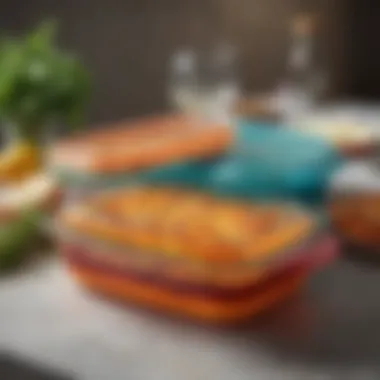
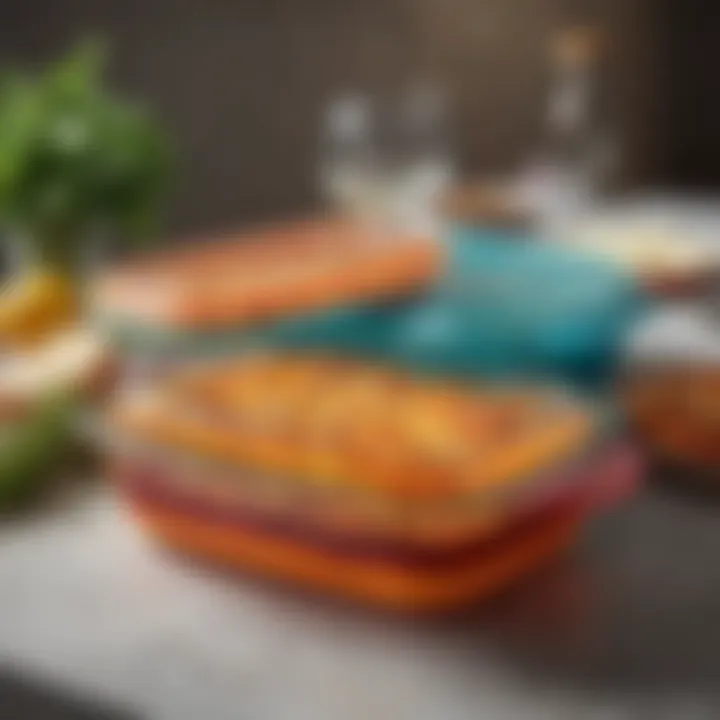
Intro
Pyrex covered casserole dishes have become an essential element in many kitchens. Their combination of functionality and durability makes them unparalleled for a variety of culinary tasks. This section will explore their versatility, from baking to serving, and the reasons why they are favored by cooking enthusiasts and professionals alike. Understanding the properties and advantages of these dishes can enhance both the cooking experience and the final results of various recipes.
Historical Significance
Dating back to the mid-20th century, Pyrex has been synonymous with durable glassware. Originally designed for safe and effective baking, their design has evolved and adapted to accommodate modern cooking needs. The iconic blue tint and clear glass construction symbolize quality and resilience. These dishes not only serve functional purposes but also reflect a rich culinary history that celebrates home cooking.
Applications in Modern Cooking
Today, Pyrex casserole dishes can be found in kitchens all over the world. Their heat-resistant glass makes them suitable for various cooking techniques, such as baking, roasting, or even reheating leftovers. They are also convenient for meal prep, allowing one to cook a dish and store it in the same vessel for easy serving later. This functional design simplifies the cooking process, making it accessible for any skill level.
Unique Characteristics
Pyrex dishes stand out from other cookware due to their non-porous surface, which prevents odors and stains from being absorbed. Their ability to withstand thermal shock makes these dishes safe to use in an oven, microwave, or freezer. The various sizes and shapes available cater to different needs, whether one is preparing a family-sized casserole or a smaller side dish.
Preface to Pyrex Cookware
Pyrex cookware has become synonymous with reliability and versatility in the kitchen. This section aims to explore the foundational elements of Pyrex, focusing on its rich history and its noteworthy role in culinary arts. Understanding the significance of Pyrex cookware helps clarify why it remains a preferred choice for both amateur cooks and professional chefs.
History of Pyrex
The origins of Pyrex date back to 1915 when it was introduced by the Corning Glass Works company. The intention was to create a glass ware that could withstand high temperatures without breaking. The initial design was a luminous blue color, which soon evolved into the clear glass that we now associate with Pyrex. Over the decades, Pyrex has transformed from a mere kitchen tool into a household name, thanks to its innovative materials and designs. Its early popularity was driven by the increasing inclination towards baking and roasting, particularly during the mid-20th century, when home cooking surged in popularity. Pyrex's adaptability to various cooking methods solidified its position in kitchens around the world.
Significance in the Culinary World
Pyrex is not just a brand; it represents a significant evolution in kitchenware. The unique thermal properties of Pyrex glass allow for even heating and excellent heat retention. This makes it ideal for both baking and serving.
One of the key attributes of Pyrex is its resistance to temperature shock, which means it can go from the freezer to the oven without the risk of breaking. This durability makes it especially valuable for a range of culinary tasks, from everyday cooking to elaborate meal preparations.
"The beauty of Pyrex lies in its seamless transition from oven to table, allowing the food lover to present their culinary creations with elegance and ease."
In modern kitchens, Pyrex covered casserole dishes are considered essential. They are versatile and functional, catering to different cooking methods like baking, roasting, and even microwaving. The design of these dishes often includes tight-fitting lids, which enhance moisture retention during cooking and make storing leftovers hassle-free.
Understanding the Pyrex Covered Casserole Dish
Understanding the characteristics and applications of the Pyrex covered casserole dish is crucial for anyone who enjoys cooking. This cookware has been a staple in many kitchens, largely due to its unique qualities. These dishes combine functionality and aesthetic appeal, leading to their widespread use. They are not just kitchen tools; they are versatile assets that adapt to various cooking and serving needs. People who appreciate home-cooked meals find that using Pyrex can enhance their culinary experience.
Material Composition
The material composition of Pyrex casserole dishes is one of their most significant features. Most commonly, Pyrex is made from borosilicate glass which is known for its durability and resistance to thermal shock. This means that it can withstand sudden temperature changes without breaking. The glass is also non-reactive, so it will not interfere with the flavors of the food being cooked or stored. This property makes it an excellent choice for a variety of dishes, including those with acidic ingredients.
Another aspect to consider is that Pyrex's transparency allows for easy visual monitoring of the cooking process. Cooks can check the progress without removing the cover. This is particularly useful for dishes that require precise cooking times. Plus, it is dishwasher safe, making cleanup convenient after a meal.
Design Features
The design features of Pyrex casserole dishes contribute to their popularity. They come in various sizes, shapes, and colors. This variety allows for versatile use; some people use smaller dishes for individual servings while larger ones are perfect for family gatherings. The clear glass design is appealing because it showcases the beautiful layers and colors of the food inside, making it good for serving directly from the oven to the table.
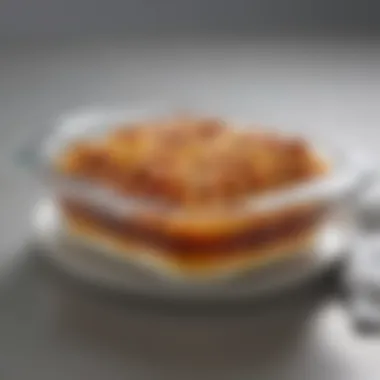
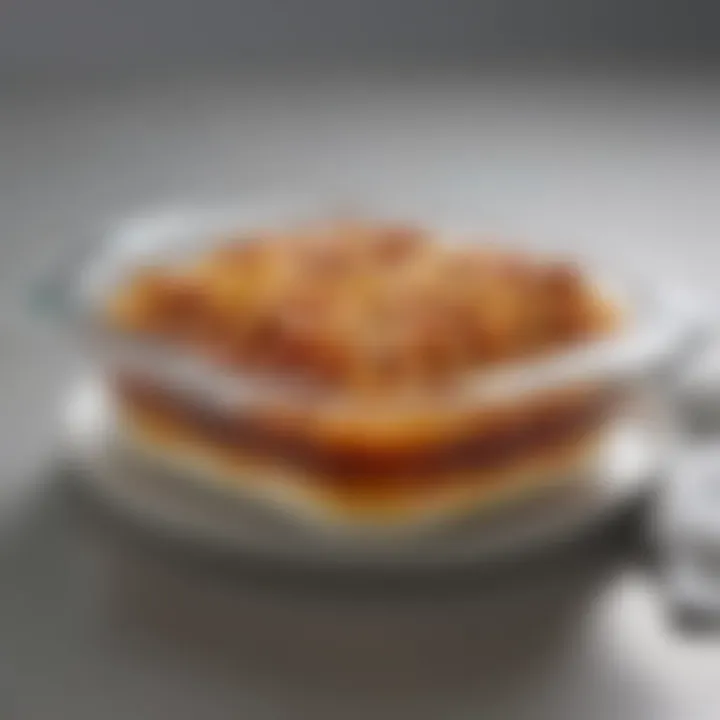
Additionally, many Pyrex casserole dishes come with matching lids. The lids are designed to create a tight seal, which helps retain flavors and moisture while cooking. This is beneficial for slow-cooking dishes and those that require longer baking times. The design is also practical, as the lids facilitate stacking for efficient storage, and they often have an easy-to-grasp handle.
In summary, the material composition and design features of Pyrex covered casserole dishes underscore their essential role in modern cooking. They are excellent not only for preparing meals but also for serving and storing them. Understanding these aspects can help culinary enthusiasts make informed decisions in their cooking endeavors.
Culinary Applications of Pyrex Casserole Dishes
The use of Pyrex covered casserole dishes extends far beyond merely holding food. Their design, material, and versatility make them an essential item in any kitchen. This section discusses key culinary applications where these dishes shine, offering insights into their significance in cooking. Pyrex casserole dishes are not just functional; they embody a unique blend of innovation and tradition that appeals to both seasoned chefs and home cooks alike.
Baking and Roasting
Baking and roasting are perhaps the most well-known uses for Pyrex casserole dishes. The glass material allows for even heat distribution, leading to consistent cooking results. When baking items like lasagna or roasted vegetables, Pyrex provides even browning and helps in achieving the desired texture.
The non-porous surface of Pyrex prevents the absorption of odors, making it great for a variety of dishes. You might enjoy a savory ratatouille one day, followed by a sweet dessert the next, all in the same dish. This saves both time and effort in washing-up. Noteworthy is how the transparent material lets you monitor your food without opening the oven door, preserving heat and ensuring a better final product.
Storing and Reheating
Pyrex casserole dishes are also remarkable for storage and reheating. Their ability to withstand temperature changes means they can go directly from the oven to the refrigerator. After preparing a meal, you can simply cover the dish with its lid and store leftovers without the need for additional containers. This characteristic not only simplifies the process but also minimizes the number of dishes used.
When reheating, Pyrex facilitates easy monitoring. Since you can reheat directly in the same dish, there is no need for transferring food. Plus, glass does not leach chemicals like some plastics, making it a safer option for heating. Prepare for a quick lunch the day after having a delightful casserole meal without unnecessary hassle.
Serving Suggestions
Serving from a Pyrex casserole dish provides both aesthetic and practical advantages. The stylish design makes it suitable for bringing dishes directly to the table. You can create an impressive presentation by serving your meal straight from the oven.
Utilizing a Pyrex dish can elevate meals for gatherings. Friends and family can admire the beautiful layers of your lasagna or the colorful vegetables in your ratatouille. Instead of worrying about transferring to another bowl, simply set the Pyrex on the table and let the food speak for itself. This approach not only saves time but also retains the warmth of the dishes, enhancing the dining experience.
In summary, Pyrex covered casserole dishes excel at baking, roasting, storing, reheating, and serving. Their versatile design and practical benefits make them indispensable tools in the kitchen. Understanding how to use these dishes effectively opens up a world of culinary possibilities.
Benefits of Using Pyrex Casserole Dishes
Pyrex covered casserole dishes provide numerous advantages that enhance cooking, storing, and serving food. Their unique construction and design allow chefs and home cooks alike to enjoy greater convenience and efficiency in the kitchen. In this section, we will explore three key benefits: durability and resistance, heat retention properties, and versatility in cooking methods.
Durability and Resistance
One of the standout features of Pyrex casserole dishes is their remarkable durability. Made primarily from borosilicate glass, they can withstand extreme temperature changes without breaking. This material is known for its strength, making it a reliable choice for both baking and freezing. Unlike some other materials that may warp or become damaged after repeated use, Pyrex remains intact through countless meals.
Maintenance is generally simple as well, as glass surfaces do not stain easily or absorb odors like plastic. This leads to a cleaner cooking experience and ensures that each dish retains its original quality over time. Furthermore, Pyrex is also resistant to bubbling, cracking, or flaking, which can be common in inferior cookware.
Heat Retention Properties
Another significant benefit is the exceptional heat retention of Pyrex casserole dishes. When you bake a casserole, the glass evenly distributes heat throughout the dish. This characteristic helps to cook food uniformly, reducing the chances of hot or cold spots. Regardless of the cooking method employed, the heat retention ensures that your dish remains warm for longer periods, making serving easier.
"The heat retention capabilities of Pyrex ensure that your meals maintain their warmth and flavor, providing an enjoyable eating experience."
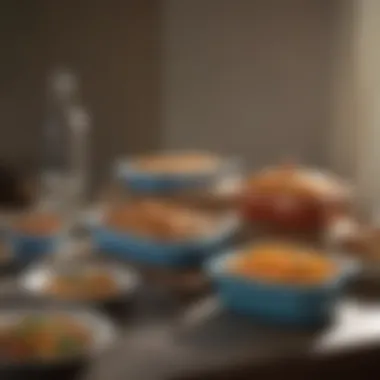
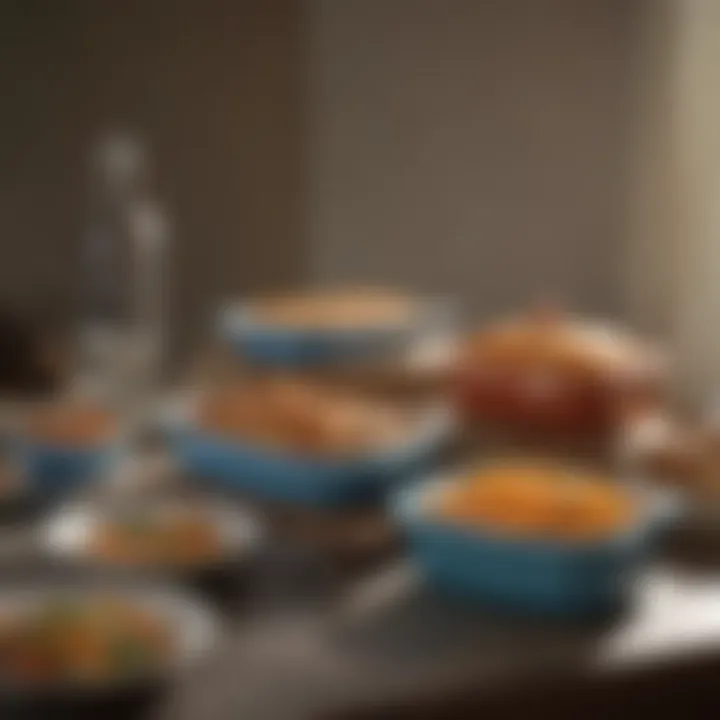
Moreover, a Pyrex dish transfers its heat gradually, which is crucial for dishes that require slow cooking. This slow-release feature is beneficial for achieving flavors that require time to develop fully.
Versatility in Cooking Methods
The versatility of Pyrex casserole dishes cannot be overstated. From oven baking to microwave cooking, these dishes are adaptable to various culinary techniques. Their design allows them to transition seamlessly from the oven to the refrigerator, and then back to the oven without any issues.
Here are some common applications:
- Baking casseroles: Ideal for lasagna, macaroni and cheese, or any layered dish.
- Microwaving: Great for reheating leftovers or cooking quick meals.
- Freezing: Perfect for storing meals for later use.
Pyrex dishes also come in various sizes, making them suitable for small servings or family-sized portions. This flexibility is essential in catering to different cooking needs, whether for a single dish or preparing multiple meals in advance.
In summary, the benefits of using Pyrex casserole dishes are significant. Their durability, heat retention, and versatility make them an excellent investment for any kitchen.
Care and Maintenance of Pyrex Casserole Dishes
The longevity and usefulness of Pyrex covered casserole dishes heavily rely on proper care and maintenance. Understanding how to maintain these dishes can prevent damage, enhance their appearance, and ensure they continue to perform optimally in various cooking scenarios. In this section, we will delve into two primary aspects: the correct cleaning techniques and methods to prevent damage.
Cleaning Techniques
To keep Pyrex casserole dishes in excellent condition, it is essential to adopt effective cleaning methods. Regular cleaning not only maintains hygiene but also preserves the visual appeal.
- Immediate Cleaning: After use, it is best to clean the dish promptly. Letting food residue sit can lead to tougher stains and odors.
- Warm Soapy Water: Most Pyrex dishes can be washed with warm soapy water and a soft sponge. Avoid abrasive pads, as they can scratch the surface.
- Baking Soda Paste: For stubborn stains, mix baking soda with a little water to create a paste. Apply it to the stained area, let it sit for about 15 minutes, then gently scrub and rinse.
- Dishwasher Safe: Many Pyrex products are dishwasher safe. However, it is advisable to place them on the top rack to avoid direct contact with heating elements.
Preventing Damage
Preventing damage to Pyrex casserole dishes involves a few key practices that help guard against thermal shock and physical impacts. By adhering to these guidelines, users can avoid costly replacements.
- Avoid Sudden Temperature Changes: Do not place a hot casserole dish directly into cold water or a cold surface. This can cause thermal shock, resulting in cracks or breaks.
- Use Silicone or Wooden Utensils: Metal utensils can scratch the surface. Opt for silicone or wooden tools to minimize the risk of damaging your dishes.
- Proper Stacking: When stacking dishes, place a soft cloth or paper towel between them. This reduces the chance of scratches and chips.
- Storage: Store in a safe location where they are less likely to fall or be jostled. Consider using organizers for additional protection.
Maintaining Pyrex casserole dishes is essential for preserving their utility and aesthetics. By employing the right cleaning techniques and taking preventive measures, users can ensure that their dishes remain a staple in their culinary endeavors for many years to come.
Casserole Recipes for Pyrex Dishes
Casserole recipes are integral to showcasing the functionality and adaptability of Pyrex covered casserole dishes. These recipes effectively emphasize the ease of transition from oven to table, capitalizing on the thermal properties of Pyrex that maintain heat and create a visually appealing presentation. Casserole dishes offer a practical avenue to explore diverse ingredients, making it possible to whip up hearty meals that cater to various dietary preferences.
Given their spacious design, Pyrex casserole dishes facilitate cooking for families or gatherings, simplifying meal preparation and serving. The versatility in styles—from layered casseroles to one-pot meals—allows cooks to experiment with flavors and textures. Moreover, they provide an opportunity to optimize the nutritional value of ingredients, thus encouraging healthier eating habits, which is significant in today's culinary landscape.
Classic Casserole Dish Recipes
Classic casserole dishes hold a cherished place in many kitchens. They typically involve basic ingredients, often resulting in comforting meals that remind people of home cooking. Here are a few favored options:
- Green Bean Casserole: A simple combination of green beans, cream of mushroom soup, and crispy onions serves as an essential side for many family dinners, particularly during holidays.
- Tuna Noodle Casserole: This dish blends tuna, noodles, peas, and creamy sauces, baked together until bubbly and golden. It is an easy recipe popular for its comforting flavors and quick prep time.
- Lasagna: Layered with cheese, sauce, and noodles, this iconic dish can easily be prepared in a Pyrex casserole dish. It retains moisture effectively, ensuring a delightful texture.
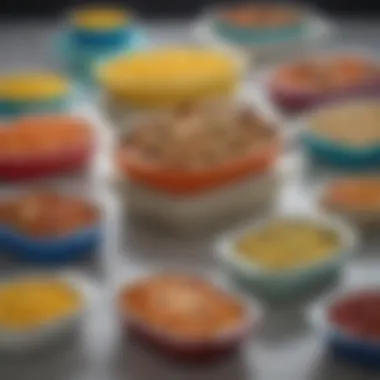
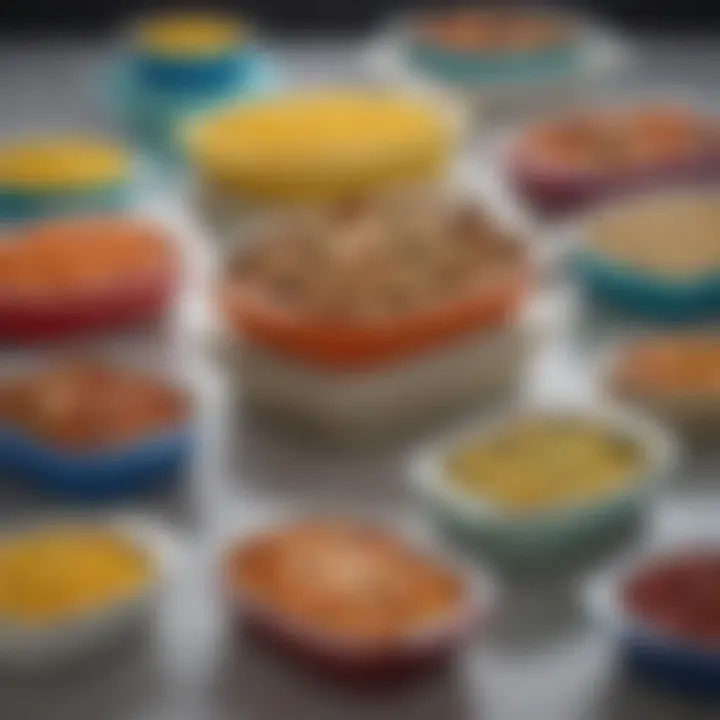
These recipes demonstrate how Pyrex can excel in preparing classic favorites, providing consistent results that cater to nostalgic tastes.
Healthy Alternatives
As dietary preferences shift, the demand for healthier meal options grows. Using Pyrex casserole dishes, one can create nutritious alternatives without compromising flavor. Here are some healthy options to consider:
- Quinoa and Vegetable Bake: Combining quinoa with an array of vegetables, topped with light cheese, this dish is rich in protein and fiber.
- Cauliflower Mac and Cheese: By substituting pasta with cauliflower, one can enjoy a lower carb option while still relishing in creamy deliciousness.
- Chickpea and Spinach Casserole: Chickpeas provide protein and paired with spinach and spices, this casserole is rich in essential nutrients.
These alternatives not only cater to those seeking healthier choices but also emphasize the adaptability of Pyrex dishes in accommodating various ingredients and cooking methods. By utilizing these recipes, home cooks can appreciate the versatility of Pyrex cookware in their everyday culinary routines.
Comparative Analysis with Other Cookware
In discussing the advantages of Pyrex covered casserole dishes, it is essential to place them within a broader context of cookware. This comparative analysis allows culinary enthusiasts to discern how Pyrex stands out amongst other materials. Factors such as heat distribution, durability, and versatility are critical in evaluating cookware. Understanding these differences can aid consumers in making informed decisions that best suit their cooking needs and preferences.
Pyrex vs. Ceramics
When comparing Pyrex to ceramic cookware, several elements come into play. Both materials offer excellent aesthetic appeal, but they differ significantly in performance.
- Heat Tolerance: Pyrex dishes are made from borosilicate glass, which can withstand sudden temperature changes, allowing for safe transitions from oven to refrigerator. In contrast, traditional ceramic dishes may crack under extreme temperature shocks.
- Weight Consideration: Pyrex is generally lighter than ceramic. This characteristic can be advantageous when handling large dishes, especially when filled with heavy casseroles.
- Maintenance: Cleaning Pyrex is often simpler because it is dishwasher safe and resistant to staining. Ceramic, while beautiful, may require more delicate handling and care to avoid chips and scratches.
- Versatility: Pyrex can be used in a microwave, oven, or refrigerator, making it exceptionally versatile. While ceramics are suitable for oven use, many are not microwave-safe, limiting their application.
Pyrex vs. Metal Cookware
The comparison between Pyrex and metal cookware sheds light on how material choice affects cooking outcomes. Metal dishes, typically aluminum or stainless steel, have their strengths and weaknesses:
- Heat Conduction: Metal typically heats quickly and evenly, which is ideal for certain cooking methods, including frying or sautéing. However, this rapid heating can lead to overcooking some dishes if not monitored closely. Pyrex offers a slower, more uniform heating process, which can be advantageous for baking casseroles.
- Reactivity: Metal can react with acidic foods like tomatoes or citrus, which may alter flavors and affect the quality of the dish. Pyrex does not have this problem, maintaining the integrity of the food cooked within.
- Durability: Depending on the quality of the metal, some pans may dent or warp over time. Pyrex, while not impervious to breaking, is resistant to warping and maintains its shape even under high heat.
- Aesthetic Appeal: Pyrex often has a classic and transparent design that allows cooks to see the dish while cooking. Metal cookware usually lacks this feature, covering the contents during the cooking process.
"Choosing the right cookware can significantly affect your cooking experience and the final outcome of your dishes. Each material has its unique place in the kitchen."
In summary, while Pyrex covered casserole dishes demonstrate remarkable versatility and functionality, understanding their strengths relative to ceramics and metal cookware offers valuable insights in selecting the right tool for specific culinary tasks.
The End
The conclusion in this article is essential as it ties together all aspects of Pyrex covered casserole dishes, emphasizing the importance of their versatility in the culinary world. Pyrex not only serves as a practical tool in the kitchen but also adds to the aesthetic presentation of the food. This article has explored various elements, including the benefits of using Pyrex dishes, their unique features, and practical care tips. Understanding these facets enables cooking enthusiasts to maximize the functionality of their cookware.
Recap of Advantages
In reviewing the advantages of Pyrex covered casserole dishes, several key points emerge:
- Durable Material: The borosilicate glass resists thermal shock and damage. Pyrex maintains its integrity, ensuring longevity.
- Versatile Usage: These dishes can withstand various cooking methods, such as baking, roasting, and microwaving.
- Transparent Design: The clarity of the glass allows for easy monitoring of the cooking process, eliminating guesswork.
- Easy Cleanup: Pyrex dishes are often dishwasher safe, simplifying post-cooking clean-up.
Overall, Pyrex casserole dishes bring a blend of function and style to the table, making them indispensable in any kitchen.
Future Trends in Casserole Cooking
As culinary trends evolve, the use of Pyrex casserole dishes is likely to adapt to new cooking styles and preferences. Some trends to anticipate include:
- Health-Conscious Cooking: A rise in plant-based and gluten-free diets will lead to more innovative casserole recipes that cater to diverse nutritional needs.
- Smart Kitchen Integration: The integration of technology into cooking may inspire smart Pyrex products that assist with temperature monitoring and cooking times.
- Sustainable Practices: Eco-friendly cooking habits may encourage the use of durable, reusable dishware like Pyrex, reducing reliance on single-use materials.
These factors indicate that Pyrex will remain relevant in modern cooking, continually adapting to meet the changing needs of culinary enthusiasts and home cooks alike.







